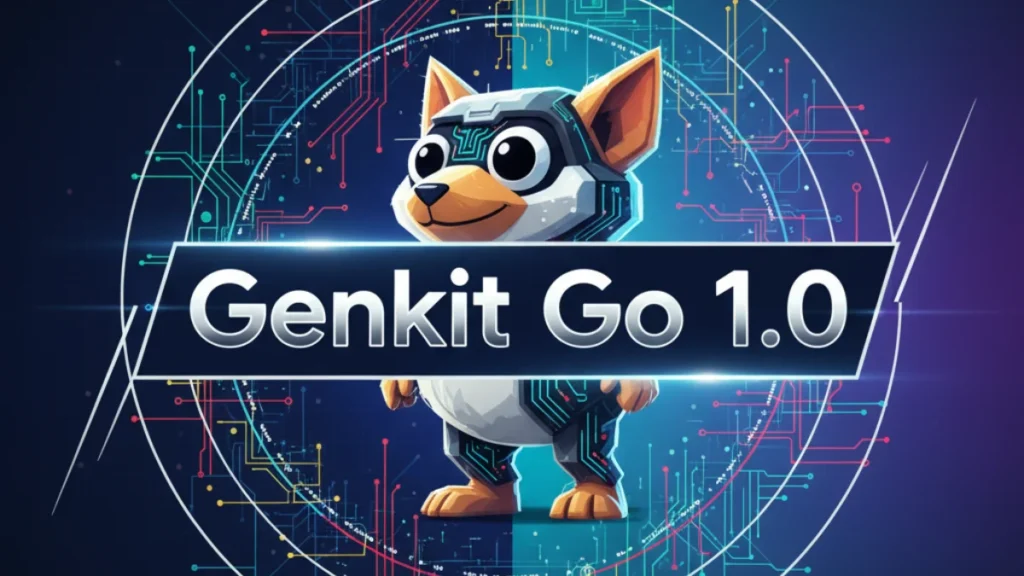Google has officially launched Genkit Go 1.0, the first stable, production-ready release of its open-source AI framework for the Go ecosystem. Alongside this comes the genkit init:ai-tools command, designed to supercharge AI-assisted development by seamlessly connecting popular coding assistants like Gemini CLI, Claude Code, and Firebase Studio.
This release signals a major shift: AI in Go is no longer experimental—it’s ready for real-world apps.
What is Genkit Go 1.0?
Genkit is an open-source framework designed for building full-stack AI-powered applications. It acts as a unified interface across multiple AI model providers, letting developers build apps that combine multimodal AI, structured outputs, retrieval-augmented generation (RAG), tool calling, and agentic workflows.
Genkit Go 1.0 is the first stable release for the Go ecosystem, meaning developers can now build and deploy production-ready AI apps using Go’s trademark speed, simplicity, and reliability.
Think of it as Go meets AI—at scale.
Why It Matters
Until now, Go developers lacked a production-grade AI toolkit with type safety, stability, and enterprise-level reliability. With Genkit Go 1.0, Google has changed the game.
Key Takeaways:
- Stable foundation: API stability across all 1.* versions, just like Go itself.
- Type-safe flows: Strongly typed Go structs for predictable AI outputs.
- Unified AI interface: Work with Google AI, OpenAI, Anthropic, Vertex AI, and Ollama using one API.
- Multimodal & RAG: Handle text, images, structured data, and real-time retrieval.
- AI assistant integration: genkit init:ai-tools connects assistants like Gemini CLI for instant help.
Installing Genkit Go 1.0
Getting started is straightforward—no heavy setup required.
# 1. Create a new project
mkdir my-genkit-app && cd my-genkit-app
go mod init example/my-genkit-app
# 2. Install Genkit
go get github.com/firebase/genkit/go
# 3. Install the Genkit CLI (macOS/Linux)
curl -sL cli.genkit.dev | bash
# For Windows: download directly from cli.genkit.dev
The CLI is the central tool, letting you run flows, test prompts, and launch the Developer UI.
Your First Genkit Flow
Genkit uses flows—functions designed for AI workflows. Here’s a minimal example where Genkit generates a structured recipe:
type RecipeInput struct {
Ingredient string `json:"ingredient"`
}
type Recipe struct {
Title string `json:"title"`
Ingredients []string `json:"ingredients"`
Instructions []string `json:"instructions"`
}
func main() {
ctx := context.Background()
// Initialize Genkit with Google AI
g := genkit.Init(ctx,
genkit.WithPlugins(&googlegenai.GoogleAI{}),
genkit.WithDefaultModel("googleai/gemini-2.5-flash"),
)
recipeFlow := genkit.DefineFlow(g, "recipeGeneratorFlow",
func(ctx context.Context, input *RecipeInput) (*Recipe, error) {
prompt := fmt.Sprintf("Write a recipe using %s", input.Ingredient)
recipe, _, err := genkit.GenerateData[Recipe](ctx, g, ai.WithPrompt(prompt))
return recipe, err
})
recipe, _ := recipeFlow.Run(ctx, &RecipeInput{Ingredient: "avocado"})
recipeJSON, _ := json.MarshalIndent(recipe, "", " ")
fmt.Println(string(recipeJSON))
}
When run, the AI produces a clean, structured recipe object instead of free-form text.
Switching AI Models Seamlessly
One of Genkit’s biggest advantages is its unified model interface. You can swap providers with a single line change:
// Google Gemini
resp, _ := genkit.Generate(ctx, g,
ai.WithModelName("googleai/gemini-2.5-flash"),
ai.WithPrompt("Explain quantum computing."),
)
// OpenAI GPT
resp, _ = genkit.Generate(ctx, g,
ai.WithModelName("openai/gpt-4o"),
ai.WithPrompt("Summarize today’s AI news."),
)
// Ollama local model
resp, _ = genkit.Generate(ctx, g,
ai.WithModelName("ollama/llama3"),
ai.WithPrompt("Tell me a philosophical quote."),
)
No lock-in, no headaches.
Tool Calling: Giving AI Real Capabilities
With tool calling, Genkit lets AI models execute custom functions or APIs:
type WeatherInput struct {
Location string `json:"location"`
}
getWeather := genkit.DefineTool(g, "getWeather",
"Fetches weather for a location",
func(ctx *ai.ToolContext, input WeatherInput) (string, error) {
return fmt.Sprintf("The weather in %s is sunny, 72°F.", input.Location), nil
})
resp, _ := genkit.Generate(ctx, g,
ai.WithPrompt("What’s the weather in San Francisco?"),
ai.WithTools(getWeather),
)
This means AI apps can provide live, accurate, actionable results.
Developer UI and CLI
The Developer UI is a visual tool for testing and debugging:
- Run flows interactively with different inputs
- Trace execution step by step
- Monitor latency, token usage, and cost
- Experiment with prompts and models
Start it with:
genkit start -- go run .
AI-Assisted Development: genkit init:ai-tools
The most exciting addition is the AI-assistant integration. Running:
genkit init:ai-tools
…automatically configures coding assistants (Gemini CLI, Claude Code, Firebase Studio, Cursor) to work with your Genkit project.
With it, developers can:
- Query Genkit documentation instantly
- Generate Go code following best practices
- Debug flows by analyzing traces
- Test inputs and edge cases with AI-generated data
It’s like having a pair-programmer built into your terminal.
Quick Start Workflow
Here’s the full flow in minutes:
# 1. New project
go mod init example/my-genkit-app
# 2. Install Genkit & CLI
go get github.com/firebase/genkit/go
curl -sL cli.genkit.dev | bash
# 3. AI assistant setup
genkit init:ai-tools
# 4. Create your first flow (recipe generator)
# 5. Start Developer UI
genkit start -- go run .
The Bigger Picture
By blending Go’s performance and simplicity with Genkit’s AI-powered design, Google has given developers the tools to build AI apps that are scalable, testable, and production-grade.
Businesses can now:
- Prototype features faster
- Deploy with confidence
- Leverage multiple AI providers without lock-in
- Supercharge workflows with AI assistants
Conclusion
Genkit Go 1.0 is more than just a new framework—it’s a signal from Google that AI in Go is here to stay. For developers, it unlocks a future where building intelligent, reliable, and production-ready apps feels natural.
The only question left: what will you build first?
Source and More Google Blog
